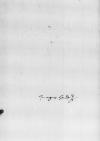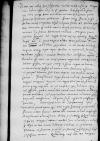⌊⌋ Vestrae Reverendissimae Dominationis ea hora redditae sunt mihi, cum iam ⌊diaeta Regni generali⌋ transacta ⌊Piotrcovia⌋ excessurus eram proptereaque, cum nec punctum otii superesset mihi ad eas tum legendas, hucusque et rescriptum distuli. Censuit ergo illis ⌊⌋ Vestra Reverendissima Paternitas, ut oratores illustris ⌊principis Prussiae⌋ causa finium inter ⌊Lithuaniae⌋ et ⌊Prussiae ducatus⌋ ex aequo et bono iuxta litteras transactionis regundorum ad nos, ⌊Regni senatores⌋, missi et benigne audirentur, et cum spe potiundi optati remitterentur. Quae res quia mihi quoque nullo monitore ita visa est, pro mea nostrumque istic omnium erga illustrem ipsum ⌊principem⌋ observantia scripsimus ad sacram ⌊regiam maiestatem⌋, dominum nostrum clementissimum, rogantes, ut ipsum illustrem amicum et feudalem principem pro dignitate tractaret, causam vero ipsorum limitum, quae in controversia est, secundum litteras transacti statui velit. Qua de re oratores etiam suae illustri ⌊dominationi⌋ ea humanitate sese exceptos fuisse absolutosque a nobis incunctanter credo istic rettulere (quia et ⌊comitiis⌋ agitandis non adeo multum temporis insumptum per nos erat). Hoc si quidem nobis suadebat eius illustris ⌊dominatio⌋ in sacram ⌊regiam maiestatem⌋, nostra vero in eius illustrem dominationem propensio.
Nihilominus, cum nostrae voluntatis fuimus intereaque sumus domini, eventus tamen non item in manu nostra esse potest. Quem ego talem futurum spero, quantum iustitiae causa unius cuiusque in sese habuerit.
Cupio tandem Vestram Reverendissimam Paternitatem longum sanam et felicem vivere.
Cuius amicitiae me commendo diligenter.
Reverendissime Domine, amice plurimum observande.
Cum non parva laetitia ⌊⌋ manu eiusdem scriptae a me lectae sunt, in quibus vidi eandem Vestram Reverendissimam Paternitatem de amicitia erga se mea subdubitare, ac si offensionum, si quae antea intercesserant, hucusque non essem immemor, obtestans, ut reiectis oblitteratisque illis ad priorem erga illam redeam amicitiam etc. Persuasum igitur habeat Vestra Paternitas Reverendissima iamdudum illarum, si quae antea intercesserant, offensionum me omnino esse immemorem deliberatumque est iamdudum apud me potius beneficio inimicitias vincere, quam odii mutui pertinacia pensare, praesertim cum non dubitem Vestram quoque Reverendissimam Paternitatem hoc idem secum facile deliberaturam atque vicem amicitiae mihi reddituram etc. quam et affectus amoris. Necnon crebriora eiusdem ad me scripta ita esse testabantur, opera item mea si eidem esse usui sentiet, facile pro libitu agnoscet etc.
Oratores illustris ⌊ducis Prussiae⌋ ita per nos excepti et tractati sunt, prout par erat. Si tamen magis tempestive ⌊⌋ eiusdem mihi datae fuissent, praesetulissem forsan me magis erga illos solito, ut Vestrae Reverendissimae Paternitatis non inanem esse agnovissent interpellationem. Est enim eritque mihi cordi semper votis eiusdem me accommodare praecipue, dum id non ingrata mente eandem a me accepturam bonique consulturam agnoscam etc.
Actum ut in scriptis etc. etc.
Idem manu propria scripsit.
Desuetus lingua Germanica eidem rescribere non potui, id ergo, ut boni consulat, rogo etc.
In aigner handt etc.
Nova, quae nobis huc transmittit multis modis infelix ⌊Hungaria⌋, nolui esse Vestrae Reverendissimae Paternitati ignota. Ea si quidem sunt, quae nobis quoque hanc vel illam utinam feliciorem, quam speramus, fortunam pollicentur. Sciat itaque ⌊Turcos⌋ post ⌊Budam⌋ armis occupatam nihil reliquum facere, ut Budam ipsam tam commeatu, quam milite maiore, muris praeterea fortioribus muniant et ex firma firmiorem reddant. ⌊Hungari⌋ porro partium serenissimi ⌊Romanorum regis⌋ vires imperii ipsiusque serenissimi regis Romanorum (quas magnas affore fama pollicetur) iam fere accincti ad bellum exspectant et ut iunctis viribus regnum unaque regni caput Budam a ⌊tyrannide Turcarum⌋ vindicare possint, iuvante domino Deo avidissime cupiunt. Orandum est certe, ut Deus Optimus Maximus antea parum feliciter gesta corrigat nosque in spem erigat meliorem, ne tam violentus hostis ad maiora etiam facinora aspiret et quicquid libuerit, sibi licere impune iam tandem animos sumat. ⌊Transilvaniae⌋ regni omnes ordines serenissimae ⌊reginae Hungariae⌋, serenissimi nostri ⌊regis⌋ filiae, partes secuti, iam fidem quoque eius maiestati ac ex ea ⌊filio⌋ regio dederunt. Quae res efficit, quod in tanto illic omnium rerum tumultu in neutram partem inclinant, sed propemodum conivent ad omnia solam
exspectando occasionem, ad quem sese applicent potissimum parietem. ⌊Monachus⌋ vero ille thesaurarius episcopus Varadiensis, penes quem tempore olim ⌊regis Ioannis⌋ propemodum summa rerum fuerat, etiam nunc omnium ordinum consensu ⌊Transilvaniae⌋ administrator dictus praefectusque est. Quod tamen ⌊reginam Hungariae⌋ attinet, mallet huc, ut intellexi, redire, quam illic in tam varia bellorum civilium et exterorum fortuna et suorum perfidiae et Turcicis infidis praesidiis exposita manere. Quantumcumque ⌊eius maiestati⌋ tam ⌊Hungari⌋ fidem dant commeatumque suppeditant, quam ⌊Turci⌋ patrocinia promittant. Is tame[n] forsan annus declarabit, quid deinceps nobis sperandum erit et quo fortuna orbis propemodum totius inclina[bit] hidden by binding. Timendum ideo esset, ne iratum Dominum Deum amplius exasperemus et ad iustam vindictam iustum iudicem provocemus.






